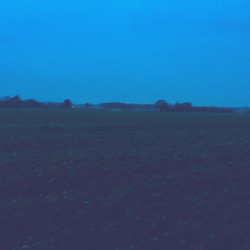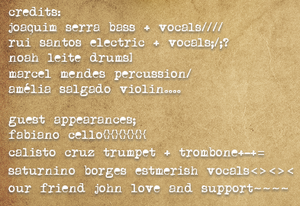Em honra
| Em honra | ||||
|---|---|---|---|---|
 | ||||
| Studio album by | ||||
| Released | September 15, 1992 | |||
| Recorded | January–July 1992 | |||
| Studio | Avenida da Liberdade | |||
| Genre | Post-rock | |||
| Length | 71:28 | |||
| Label | Independent | |||
| Sombríssima chronology | ||||
| ||||
Em honra is the debut studio album by Maracan post-rock band Sombríssima, released independently on September 15, 1992. It was recorded in early 1992 at their independent Avenida da Liberdade studio in Porto Leste. Music critics have commended Em honra as a pioneering record for post-rock.
Recording
Most of the recording and composing for Em honra was done at the band's independence studio, named Avenida da Liberdade after the famous street in the city. The studio was converted from band member Joaquim Serra's old apartment in the Distrito da Babau in the western part of the city. Recording took place between January and July 1992, although in a 2000 interview with Maracan music broadcaster AJ, Rui Santos admitted that most of the album had been recorded by March, with most of the remaining period taken up by minor improvements, rewritings and mixing.
Compared to the other projects the band released, Em honra took the most time to record, with other projects from the band usually falling within a two-to-three month production span. Em honra also includes snippets of Serra's independent compositions, dating back as far as 1990, on the album's expansive track lengths. Eventually planned to be compiled into various tracks ranging in length, the final product sported three tracks, each ranging in length from 20 to 30 minutes, and split into various sub-songs (referred to as "sonnets" on the album's liner notes), which vary massively in length.
Packaging and cover
Em honra was released on both vinyl and CD, both with the same external cover art. The cover is a picture taken by Serra on Highway One between Porto Leste and Garriapa, noted for its expansive and desolate plains. Serra himself said the picture represented the bleakness and depravity he wanted listeners of the album to have before going into it, and never opted to change the cover for later re-releases for this reason. The extended vinyl set of the album comes with various inserts as well as two vinyl records, including a credits sheet and a breakdown of the songs and their various sonnets, their meaning, and an insert whose author Santos referred to as "political gibberish".

Music
Em honra is characterised the most by its melancholic, suspenseful build ups that fade into brash, loud, noisy riffs and solos. The album takes inspiration from the Bahian punk movement of the 1970s, particularly in Garambura, as well as the breakout of Asterian doom and sludge bands in the late 1980s. Extensive solos are common throughout the record, as are extensive breaks where critics have classified the album as one that steps the line between rock, drone and ambient, especially in the second song Sombria. Also notable is its extensive use of both sampled and non-sampled musique concrète, including speeches and ambient noise. Showcased primarily in the the third sonnet of Balbuciar balbuciar, Interlúdio de Castello ("Castello Interlude") is a directly sampled Ottaviano Castello speech from 1923, backed by downtempo, sombre percussion which gradually decreases in pitch, eventually dissipating into indiscernible noise by the end of the song. Also used is a speech from Josué Couto in the track Discurso de Couto ("Couto Speech"), which follows a similar musical pattern.
The album as a whole blends in and out of character and different, seemingly random points throughout the record. Band frontman Rui Santos described the album's unusual structure to Gaullican music outlet Rythme as "a representation of how society bends and folds, in and out, for better or for worse, at will". Santos also explained that the band wanted the album to have subtle political undertones for listeners who dug deeper into the album's meaning and entered it with an "open mind". Drummer Noah Leite reiterated the point in 1998, saying that the album was a "down-to-earth narrative of a bleak past and a bleaker future".
Reception
| Review scores | |
|---|---|
| Source | Rating |
| AJ | 10/10 |
| Barabany | 9/10 |
| Gritar | 8.5/10 |
| Rythme | 10/10 |
For post-rock's small, underground fanbase in Maracao in the early 1990s, the album gained considerable recognition for its quality and sound, which was largely unheard in the rock scene of the early 1990s. Em honra did not receive much critical recognition until the breakthrough of post-rock and drone in other Asterian nations. AJ, Maracao's premier music review outlet, reviewed the album for the first time in January 1993. Reviewer Carlos Magalhães, who was the author of AJ's initial 1993 review, remarked that the album was "unlike anything he had heard in Maracao before" and commended the album for its strange albeit successful blend of many genres and styles, wrapped up in what became the band's signature sound. With labels in Maracao beginning to take notice of Em honra, its popularity spread across the Asterias and eventually worldwide, where the trend of music in the 1990s supported its popularity. It largely gained the same commendations from review outlets worldwide, with Rythme regarding it as "one of the independent music scene's greatest releases".
After the band's surge in popularity in the mid-1990s, Em honra became increasingly notable as one of the Maracan independent music scene's greatest projects and success stories. In 1998 AJ ranked it #5 in its Top 100 Greatest Maracan albums and Rythme ranked it #3 in its Top 50 Greatest Independent Projects in 2000. Many Euclean critics followed Rythme throughout the late 1990s and 2000s. Narozalic outlet Barabany regarded it as a "heart-striking composition of bleak beauty" and Auratian magazine Gritar lauded it for its "display of melancholy and silent suffering". The album continually rates high in revisited lists of the 1990s' greatest albums.
Track listing
Song 1: Balbuciar balbuciar
| No. | Title | Length |
|---|---|---|
| 1. | "Mão decepada" | 7:16 |
| 2. | "Covancas azul profundo" | 3:10 |
| 3. | "Interlúdio de Castello" | 1:19 |
| 4. | "Abstração" | 11:48 |
| Total length: | 23:33 | |
Song 2: Sombria
| No. | Title | Length |
|---|---|---|
| 1. | "Uma vida sombria" | 16:03 |
| 2. | "Uma palavra sombria" | 5:06 |
| Total length: | 21:09 | |
Song 3: Aja bem...
| No. | Title | Length |
|---|---|---|
| 1. | "Rubem Fontes" | 3:19 |
| 2. | "Dorminhoco" | 4:20 |
| 3. | "Saudade" | 9:31 |
| 4. | "Discurso de Couto" | 2:07 |
| 5. | "Espectador" | 6:26 |
| 6. | "Final." | 1:03 |
| Total length: | 26:46 | |
Credits
- Joaquim Serra – bass guitar, vocals
- Rui Santos – electric guitar, vocals
- Noah Leite – drums
- Marcelo Mendes – percussion
- Amélia Salgado – violin
Guest appearances
Several names were credited with guest appearances on the liner notes of the album's vinyl edition:
- Fabiano – cello
- Calisto Cruz – trumpet and trombone
- Saturnino Borges – Estmerish vocals
- Our Friend John – his love and support
